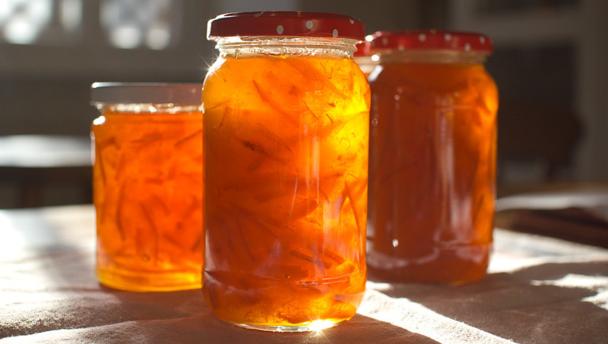

By Dan Lepard
There are two main types of oranges: sweet oranges and bitter (Seville) oranges. The former can be thick- or thin- skinned, with or without seeds, and has sweet-tasting orange or red-flecked flesh. Bitter oranges have aromatic dimpled skin with very bitter pith and very sour, pale-orange flesh. They always contain seeds.
 Spiced-up Barnsley chops
Spiced-up Barnsley chops
 Tofu croquettes with cranberry sauce
Tofu croquettes with cranberry sauce
 Christmas popcorn
Christmas popcorn
 Snowman pancakes with orange and spice
Snowman pancakes with orange and spice
 Warm, spiced oranges with labneh
Warm, spiced oranges with labneh
 Sticky jerk wings with sugared oranges
Sticky jerk wings with sugared oranges
 Sweet and sharp sea bass
Sweet and sharp sea bass
 Luxury chicken liver pâté
Luxury chicken liver pâté
 Cumin-crusted vegetables
Cumin-crusted vegetables
 Kids’ veggie slaw
Kids’ veggie slaw
 Kid’s customised couscous salad
Kid’s customised couscous salad
 Brussels sprouts in brown butter
Brussels sprouts in brown butter
 Caramelised oranges with honeyed ricotta
Caramelised oranges with honeyed ricotta
 Mary Berry’s mother’s bread and butter pudding
Mary Berry’s mother’s bread and butter pudding
 Blood orange tart
Blood orange tart
 Marmalade and almond cake
Marmalade and almond cake
 Almond and lemon polenta cake with orange mascarpone
Almond and lemon polenta cake with orange mascarpone
 Orange and almond cake
Orange and almond cake
 Eccles cakes
Eccles cakes
 Pimms punch
Pimms punch
 Fred Said
Fred Said
 Cherry negroni
Cherry negroni
 Cosmopolitan
Cosmopolitan
 Blueberry butter
Blueberry butter
 Cranberry and Cumberland sauce
Cranberry and Cumberland sauce
Navel, Valencia and blood oranges are the main types of sweet oranges. They are used in both sweet and savoury dishes, but where necessary add a little lemon juice or zest to strengthen their flavour.
Use sweet oranges in savoury salads minced with some of the following: bitter leaves, pomegranate seeds, feta, red onion and olives. Use their freshly squeezed juice in butter sauces or dressings.
Sweet oranges are widely used in sweet dishes - flavoured with caramel, cinnamon or orange flower water - or as a flavouring for chocolate or rhubarb. Finely grated or julienned orange zest adds a touch of bitterness to cakes and desserts.
Article by Sybil Kapoor
Type the ingredients you want to use, then click Go. For better results you can use quotation marks around phrases (e.g. "chicken breast"). Alternatively you can search by chef, programme, cuisine, diet, or dish (e.g. Lasagne).